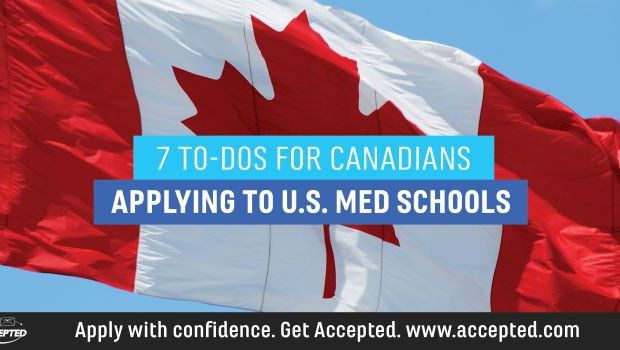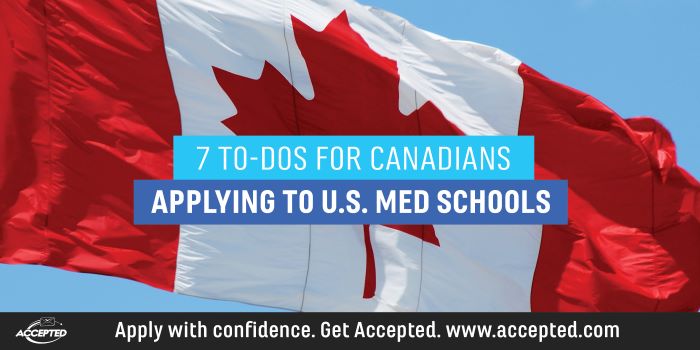7 To-Dos for Canadians Applying to U.S. Med Schools

7 To-Dos for Canadians Applying to U.S. Med Schools



Each year, Canadian medical school hopefuls look across the border for their medical education. While there are obvious challenges (adapting to a different health care system, returning to a Canadian residency, and much higher education costs), the higher acceptance rates at U.S. programs (about 36.2% overall per AAMC, as compared to around 19.6% in Canada) can make an American medical education appealing.
If you’re a Canadian considering going south for medical school, here are some things you should keep in mind:
1. Think about life after medical school
Your future path will be determined by choices you make now. Do you want to return to Canada for your residency training? In that case, you probably want to pursue allopathic medicine; graduates of accredited U.S. allopathic medical schools are eligible for the Canadian R-1 match.
Osteopathic graduates can apply for the CaRMS R-1 match as well, but at this time, only Quebec accepts them unconditionally; other provinces consider them international medical graduates (IMGs) with additional qualifications. However, with the recent (2020) combined match in the U.S. blurring the distinction between osteopathic and allopathic training, it is likely that there will be increased recognition of D.O. graduates in the next few years.
If you’re happy to stay in the U.S. for your residency, an osteopathic program could be a great fit. American-trained D.O. residents are recognized by the College of Family Physicians of Canada, smoothing the path for your return after residency.
2. Timing is critical
The U.S. application season starts much earlier than the Canadian one. While it is possible to apply later in the season, to give yourself the very best chance as an international applicant, you should aim to be in the very first batch of applications. This means you need to:
- Submit your primary application as early as possible. For allopathic schools, the application season started on May 3rd and the first day to submit is May 31st; for osteopathic schools, the season started on May 4th and you can submit as soon as you’re ready.
- Turn around your secondary essays promptly (within 10-14 days of receipt).
This timing results in a grueling schedule, but one that will pay off in acceptances. If you’re accepted, it also allows time (which can be extensive) to secure the I-20 visa required for study in the U.S.
3. Apply selectively
The Medical School Admission Requirements™ (MSAR®) is your source for information about each school. If you filter U.S. schools that consider applications from Canadians, you’ll see a list of 59 programs. However, you have to deep dive into the fine print. For instance, Canadian alumni of the University of Nebraska and the University of Rochester are welcome to apply at these schools, but not other Canadians. Canadians with 20 science hours at U.S. institutions are welcome at the University of Cincinnati. Others, such as Mayo and Wake Forest, say that they accept Canadian applications on a case-by-case basis, but the fine print requires U.S. citizenship or permanent residency. The University of Arizona accepts applications from Canadians, but requires that they hold U.S. citizenship or permanent residency by the time of matriculation.
Admissions committees that accept Canadian applicants more widely still evaluate them in different ways. Some allopathic schools consider them as international applicants subject to more rigorous acceptance criteria. They may be considered after U.S. applicants. Schools in this category include:
U.S. med schools that consider Canadian candidates as international applicants
| Program Name | Acceptance rate for all international applicants |
| Columbia University Vagelos College of Physicians & Surgeons | 0.58% |
| Duke University School of Medicine | 0.76% |
| Emory University School of Medicine | 2.87% |
| Howard University College of Medicine | 2.05% |
| New York Medical College | 2.05% |
| Northwestern University The Feinberg School of Medicine | 3.09% |
| Rutgers Robert Wood Johnson Medical School | 0% |
| Saint Louis University School of Medicine | 3.80% |
| San Juan Bautista School of Medicine | 0% |
| Tufts University School of Medicine | 0.39% |
| University of Colorado | 1.50% |
| University of Connecticut School of Medicine | 0.41% |
| University of Illinois College of Medicine | 7.38% |
| University of Louisville School of Medicine | 0% |
| University of Pittsburgh School of Medicine | 1.09% |
| University of Utah School of Medicine | 0.62% |
| University of Virginia School of Medicine | 6.08% |
| Vanderbilt University School of Medicine | 3.21% |
| Warren Alpert Medical School of Brown University | 0.47% |
“Canadian-friendly” allopathic schools are those that evaluate Canadian candidates in the same way as U.S. applicants (although state schools may view them as out-of-state applicants, who often have a lower acceptance rate than in-state applicants). These schools include:
U.S. med schools that consider Canadian candidates as in the same way as U.S. applicants
| Program Name | Acceptance rate for all out-of-state applicants |
| Boston University School of Medicine | 3.59% |
| Case Western Reserve University School of Medicine | 6.17% |
| Central Michigan University College of Medicine | >.5% |
| Geisel School of Medicine at Dartmouth | 2.59% |
| George Washington University School of Medicine & Health Sciences | 1.80% |
| Georgetown University School of Medicine | 2.53% |
| Harvard Medical School | 2.58% |
| Icahn School of Medicine at Mt. Sinai | 3.19% |
| Johns Hopkins University School of Medicine | 3.88% |
| Louisiana State University School of Medicine in New Orleans | >.5% |
| Medical College of Wisconsin | >1.2% |
| Meharry Medical College | >1% |
| Michigan State University College of Human Medicine | >.32% |
| NYU Grossman School of Medicine | 2.11% |
| New York University Long Island School of Medicine | 1.06% |
| Perelman School of Medicine at the University of Pennsylvania | 4.15% |
| Renaissance School of Medicine at Stony Brook University | 5.61% |
| Rutgers New Jersey Medical School | 2.03% |
| Sidney Kimmel Medical College at Thomas Jefferson University | 3.18% |
| Stanford University School of Medicine | 1.58% |
| SUNY Upstate Medical University Alan & Marlene Norton College of Medicine | 4.71% |
| Tulane University School of Medicine | >1% |
| Universidad Central del Caribe School of Medicine | >1% |
| University of Arizona College of Medicine | 0.87% |
| University of California Los Angeles David Geffen School of Medicine | 2.15% |
| University of Chicago Pritzker School of Medicine | 3.37% |
| University of Hawaii John A Burns School of Medicine | 1.14% |
| University of Maryland | 1.64% |
| University of Massachussetts Medical School | 4.47% |
| University of North Carolina at Chapel Hill School of Medicine | 1.19% |
| Virginia Commonwealth University | 3.49% |
| Washington University in St. Louis School of Medicine | 6.63% |
| Wayne State University School of Medicine | 5.07% |
| Weill Cornell Medicine | 3.62% |
| Yale School of Medicine | 4.47% |
Still others will consider Canadian applicants on a case-by-case basis, often imposing certain restrictions. These schools include:
U.S. med schools that consider Canadian candidates on a case-by-case basis
| Program Name | Criteria |
| Keck School of Medicine of the University of Southern California | N/A |
| Loma Linda University School of Medicine | Preference to qualified members of the Seventh-day Adventist Church. |
| Mayo Clinic Alix School of Medicine | Requires proof of Canadian provincial or federal financial support |
| Ponce Health Sciences University School of Medicine | Must demonstrate proficiency in Spanish |
| University of California Davis School of Medicine | Requires strong ties to California |
| University of Cincinnati College of Medicine | Must have completed at least 20 hours of BCPM coursework at a U.S. college or university |
| University of Kentucky College of Medicine | Requires undergraduate or graduate degree in Kentucky; not eligible for loans or institutional scholarships |
| University of Nebraska College of Medicine | Requires degree from UNebraska |
| University of New Mexico School of Medicine | Requires strong ties to New Mexico or tribal affiliation |
| University of Rochester School of Medicine & Dentistry | Requires degree from URochester |
| USF Health Morsani College of Medicine | N/A |
| West Virginia University School of Medicine | N/A |
- Finally, Osteopathic schools as a whole tend to be more welcoming. Michigan State University’s “Canadian Initiative” even supports Canadian medical students interested in promoting osteopathic medicine in Canada through special tuition rates and recognition as an approved non-Canadian medical school for the Canadian residency match.
For other osteopathic schools, it’s important to remember that osteopathic medicine is not well-recognized throughout Canada and you will most likely be limited to pursuing your residency in the U.S. Ultimately you should be able to practice, but there are a number of hoops you will have to jump through.
To learn the specific requirements for schools that interest you, use the MSAR (for allopathic programs) and contact individual schools. (Although there are lists online, don’t rely solely on them. Some are too old to have the newer schools, and schools often change their policies.) Doing your research up front ensures that you don’t waste your time and money.
4. Present a well-rounded profile
Even if you curate your school list carefully, successful Canadian applicants tend to have exceptionally high MCAT scores and GPAs (American programs consider both science and non-science GPAs). Even D.O. schools, which generally rely less heavily on quantitative requirements, often require higher than average GPAs for non-U.S. applicants.
But American medical schools – more than Canadian ones – tend to look beyond quantitative measures and view applicants more holistically. For this, strong extracurricular activities (research, community service and especially clinical experience) are critical. Clinical experience has long been a challenge for Canadian applicants. Legal restrictions have always limited access to the medical arena and pandemic restrictions have exacerbated this situation.
To get around this, you’ll have to think creatively. Pursuing clinical missions abroad is one way to gain clinical experience; working as an EMT or paramedic is another. If these aren’t open to you, then find other ways to support your community, and especially its most vulnerable members. Organizations providing support for homeless communities, addiction and mental health services, food banks, etc. are frequently in need of help, and while it’s not clinical experience, it can help you demonstrate qualities like empathy and cultural competence that are very highly regarded by admissions committees.
As awful as the pandemic has been, it has opened up new opportunities for Canadian premeds. In the past, most Canadians wanting to gain shadowing experience would have to go to the U.S., where privacy and patient care regulations were less restrictive. Over the past two years, however, virtual shadowing has taken off. It’s not the same as being in an exam room with a doctor and a patient, but it’s the next best thing. And it might introduce you to some of the less common specialties that you’d not encounter in traditional shadowing experiences. Companies providing virtual shadowing abound and can be found with a quick Internet search. Some even provide certificates to verify that you were there and paying attention. You can record these hours (noting that they are virtual) on your application.
5. Choose references wisely
Find recommenders who both know you well and are prepared to write about you in glowing terms. Evaluation letters are no place for Canadian self-deprecation. When you request a letter, provide a list of your highlighted accomplishments as well as a CV, and be as direct as possible about any specific areas that you’d like your recommender to address. In most cases, they will appreciate such guidance.
6. Show your fit
When secondaries start rolling in, be ready to give the schools some love. It’s not enough to cite generic facts like “early clinical exposure” and “outstanding faculty.” Dig deeper into each program’s mission and philosophy, facilities, and specific curriculum, research, and student-led offerings. If you can’t figure out what makes the school unique, then you aren’t ready.
It’s also a good idea to highlight any connection you might have to the school/area. Have you ever been there? Did your research supervisor do postgraduate work there? Do any family members reside nearby? Will you have a support system? Citing your knowledge of the program as well as your local support network can help show your fit.
7. Prepare for interviews
Unlike Canadian schools which often use MMIs, most U.S. programs use a traditional interview format that requires you to talk about yourself. If talking extensively about your life and your experiences is not something you’re comfortable with, adding practice time to your early preparations will make a significant difference.
Bottom line
Applying to U.S. medical schools can be a tricky proposition, but if you follow these steps, you’ll be in the best shape possible.
Do you need help applying to medical school, in the U.S. or anywhere else? Explore our Medical School Admissions Services and work one-on-one with a seasoned application expert who will guide you to acceptance at the best med school for YOU.
<!–[if lte IE 8]>
<![endif]–> hbspt.cta.load(58291, ‘4b94e05c-2998-43ea-bc96-efd39d1c268c’, {});
hbspt.cta.load(58291, ‘4b94e05c-2998-43ea-bc96-efd39d1c268c’, {});

A former fellowship admissions committee member and administrator at the University of Washington School of Medicine, Cydney Foote has successfully advised healthcare applicants, including those applying to medical school, dental school, nursing and PA programs, veterinary school, public health and hospital administration programs, post-baccalaureate medical programs, residencies and fellowships. Since 2001, she has brought her marketing and writing expertise to help science-focused students communicate their strengths. Want Cyd to help you get Accepted? Click here to get in touch!
Related Resources:
- U.S. News Best Medical School (Research and Primary Care) Rankings 2023
- 7 Simple Steps to Writing an Excellent Diversity Essay
- Medical School Selectivity Index: Find medicals schools where you are a competitive applicant
The post 7 To-Dos for Canadians Applying to U.S. Med Schools appeared first on Accepted Admissions Blog.
Source: Accepted.com
7 To-Dos for Canadians Applying to U.S. Med Schools










0 comments